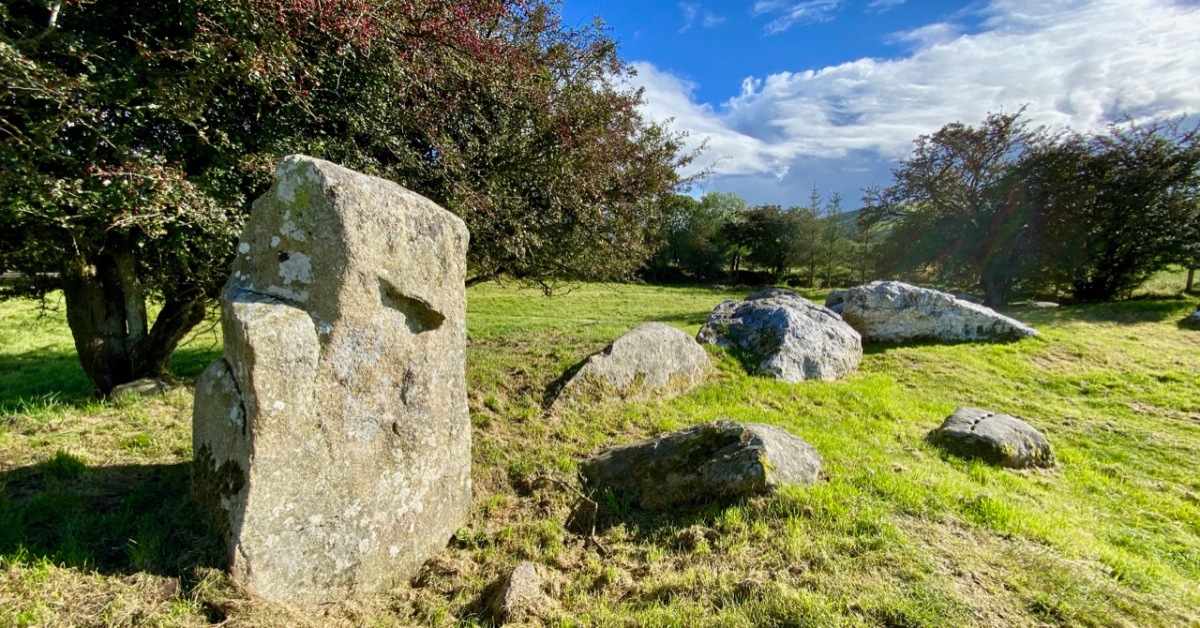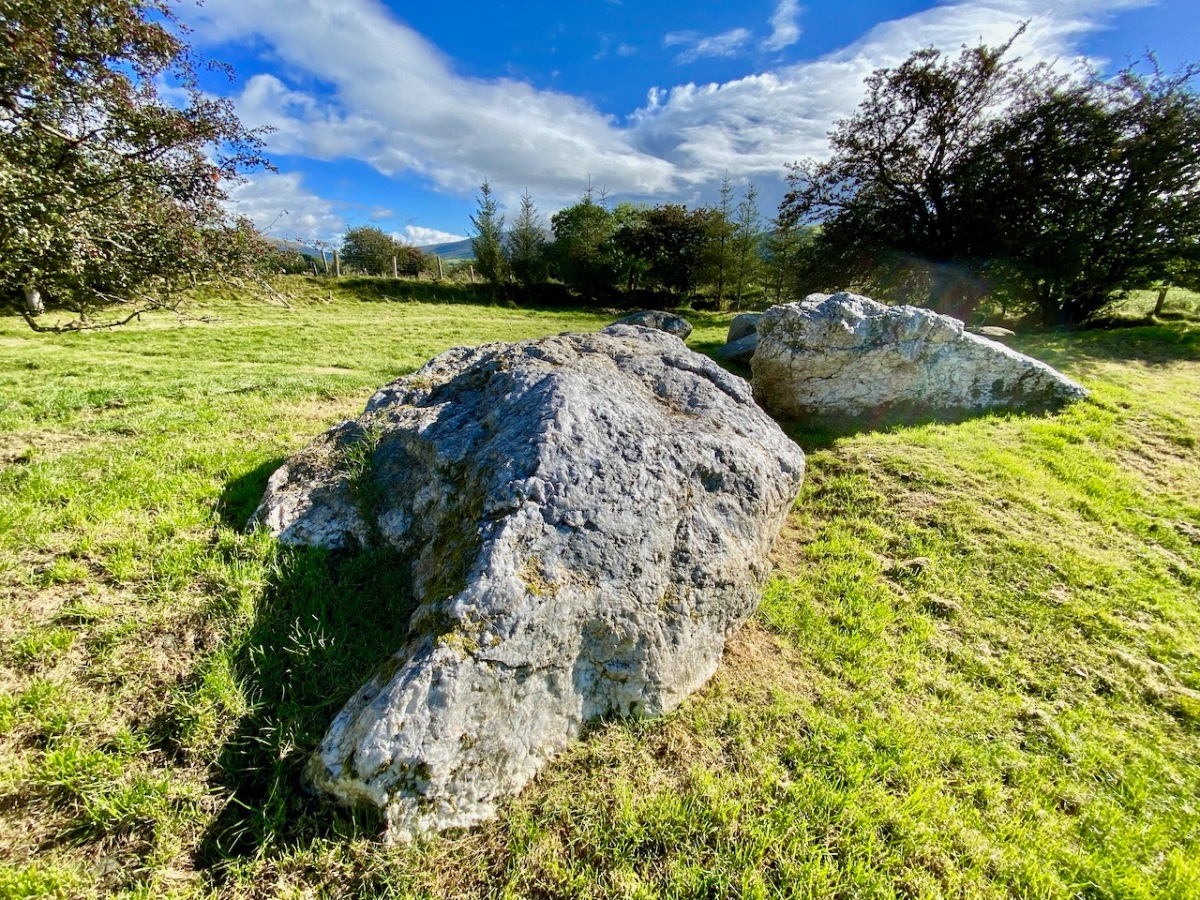
Our travels are always attuned towards our particular interests, be they history, stained glass, art or – as in this case – archaeology. We go out of our way to take in sites we have never seen before – and there are so many. When we were ‘holidaying’ in Wicklow last week we searched out this stone circle in the townland of Castleruddery Lower. It was well worth the journey.


. . . Neglected, knee-high in grass and surrounded by round-crowned hawthorns whose May blossom speckles the bank, it is difficult to appreciate how important Castleruddery must have been early in the Bronze Age when Beaker copper prospectors and the Wicklow mountain goldminers passed by its brilliant entrance. It is not properly a stone circle but a henge, with a stone-lined interior. It was constructed on the summit of a hill just east of the valley into which the Little Slaney flows. Six miles north is the lovely Athgreany stone circle and only two miles to the south is the Boleycarrigeen ring, its stones embedded in a low earthen bank . . .
Aubrey Burl, Rings of Stone, France Lincoln Publishers, 1979
The aerial view, and the extract from the 25″ Ordnance Survey map (above) show the monument in the context of the surrounding landscape. Nearby is a medieval ‘Motte’, very much younger than the ‘Druidical Circle’ – thus named on many early maps. The local Irish name – Chaisleán an Ridire – translates as Knight’s Castle, which might make you think that there is some medieval connection between the circle and the Motte, but in fact Castleruddery stone circle is likely to date from the late Neolithic, around 2,500 BC, marking it as one of the earliest of this monument type in Ireland.


We noted this little figurine by the entrance gate to the circle: it made me wonder what folklore or traditions might be associated with the site today. I could find only one reference to Castleruddery in the Duchas Schools Folklore collection, dating from 1936:

The informer here was Michael Murphy, aged 68 – a ‘labourer’ from Colliga, Co Wicklow. The School collector was from Baile Dháithí, Dunlavin, Davidstown, Co Wicklow. There was no doubt in Mr Murphy’s mind that the stones could only have been placed there by supernatural powers!



The two quartz portal stones at the east side of the circle are remarkable: deliberately chosen, no doubt, to emphasise the importance of the orientation. The circle has 29 significant stones still standing today, but there were probably more. There is evidence of attempts to break up and remove some of the stones, which would have made good building or fencing material for someone who did not share respect for the integrity of the circle.


The two views above show iron ‘drill’ markings: these were made to try and separate sections of stone to be taken away for re-use. In the upper picture one section has been removed, but the operation was unsuccessful for the remainder of the boulder. One has to wonder whether otherworldy forces intervened – and meted out some form of ‘bad luck’ to the perpetrators.




In the present day it’s territory for sheep, and they seem to be unconcerned about any ancient associations or supernatural influences interrupting their tranquil grazing. The archaeologists tell us that this is more of a ‘henge’ monument than the type of stone circle we are familiar with in West Cork. It’s certainly larger, and crop marks have shown that the 29 stones surmount an earthen ring, approximately 30 metres in diameter, and there is a further ring which was once supported or reinforced by timber. Comparisons are made with a henge circle at Grange, close to Lough Gur, Co Limerick, which we visited in 2016. There the ring of at least 113 stones has an internal diameter of 46 metres. We took the two photos below at Grange.


The Grange circle was excavated in 1939 by professor S P Ó Riordáin, and the Duchas board at the site states:
. . . The excavation indicated that the enclosure was constructed purely for sacred or ritual purposes. The bank may have provided a stand where an audience could observe ceremonies within the enclosure . . . One of the stones is known as Rannach Cruim Duibh. This suggests that the circle became associated with the festival of Lughnasa, traditionally the first Sunday in August, and a celebration of the harvest. Crom Dubh, meaning the Dark Bent One, was credited with bringing the first sheaf of corn to Ireland . . .
Duchas, Grange Circle
There must surely be connections, and common purposes, between the many similar circle monuments all over Ireland. We always want to know What was it for…? probably, we never will, but it’s part of the whole romance of archaeology to wonder about such places. We must be grateful that so much remains for us to explore.


This is a fun site. We noticed a large gold deposit in one of the quartz entry stones. It was surely just pyrite but cool none the less. We also visited Broadleas and Athgreany circles which were near by and both were quite impressive.
LikeLiked by 1 person
So much to explore, Patrick!
LikeLiked by 1 person
Brilliant photos and so interesting, Wicklow is not only beautiful it has, like all over Ireland, the most fascinating archaeological finds. Much enjoyed Robert and beautiful photography!
LikeLiked by 1 person
Thank you Gaia: Wicklow is a good ‘holiday’ destination!
LikeLiked by 2 people
This is a magnificent and iconic circle, complete with many fairy trees as is only right.
LikeLiked by 1 person
I think the quartz is a particular feature!
LikeLike
Fantastic, I will visit this at the earliest opp. Thank you for info and the – as ever – ravishing pics. Have you been to the Timoney Stones? Co Laois I think. Astonishing avenues of stones, like a miniature Brittany. Apologies if I am teaching my grandmother to suck eggs here!
LikeLiked by 1 person
No – Timoney is still on our list for a visit, Merrily! It certainly looks good.
LikeLiked by 1 person
And we must be grateful for your effort in sharing your journeys, research, and photographs….
LikeLiked by 1 person
As you know, Carol, we enjoy every moment of our explorations. Hope you will join us again one day!
LikeLiked by 1 person
One always hopes that somewhere at some time a significant snippet of information or physical clue will emerge that will be the key to understanding these ancient structures. Wishful thinking perhaps. Fascinating blog, Robert. Thank you.
LikeLiked by 2 people
Dermot, your optimism is inspiring. I’m always hoping that, while standing in one of these sites, I will hear a ‘voice from the past’ and have an enlightening conversation…
LikeLiked by 1 person